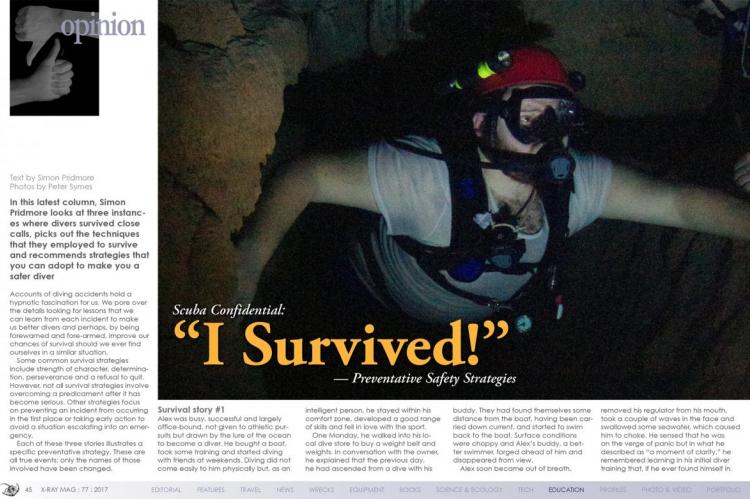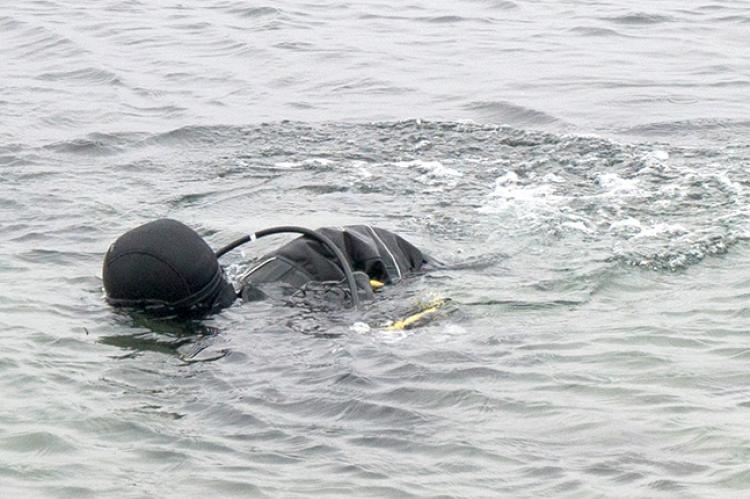I Survived! Preventative Safety Strategies
In this latest column, Simon Pridmore looks at three instances where divers survived close calls, picks out the techniques that they employed to survive and recommends strategies that you can adopt to make you a safer diver.
Tags & Taxonomy
Accounts of diving accidents hold a hypnotic fascination for us. We pore over the details looking for lessons that we can learn from each incident to make us better divers and perhaps, by being forewarned and fore-armed, improve our chances of survival should we ever find ourselves in a similar situation.
Some common survival strategies include strength of character, determination, perseverance and a refusal to quit. However, not all survival strategies involve overcoming a predicament after it has become serious. Other strategies focus on preventing an incident from occurring in the first place or taking early action to avoid a situation escalating into an emergency.
Each of these three stories illustrates a specific preventative strategy. These are all true events; only the names of those involved have been changed.
Survival story #1
Alex was busy, successful and largely office-bound, not given to athletic pursuits but drawn by the lure of the ocean to become a diver. He bought a boat, took some training and started diving with friends at weekends. Diving did not come easily to him physically but, as an intelligent person, he stayed within his comfort zone, developed a good range of skills and fell in love with the sport.
One Monday, he walked into his local dive store to buy a weight belt and weights. In conversation with the owner, he explained that the previous day, he had ascended from a dive with his buddy. They had found themselves some distance from the boat, having been carried down current, and started to swim back to the boat. Surface conditions were choppy and Alex’s buddy, a better swimmer, forged ahead of him and disappeared from view.
Alex soon became out of breath, removed his regulator from his mouth, took a couple of waves in the face and swallowed some seawater, which caused him to choke. He sensed that he was on the verge of panic but in what he described as “a moment of clarity,” he remembered learning in his initial diver training that, if he ever found himself in difficulty at the surface, he should drop his weight belt. This was something his instructor had made him practice over and over again. So, he reached down, released the buckle and his weight belt fell away.
Immediately, he found that he was floating higher in the water, his head now above the choppy waves, his mouth clear of the splashing foam. Free of the belt around his waist he found it easier to breathe. He could now see the boat and his buddy who had almost reached it. He lay back, took several deep breaths in and out and started to fin slowly but as powerfully as he could towards the boat.
Comment
Having to replace his weights and weight belt was a small price to pay for survival. It is likely that Alex only thought to remove his weight belt because he had practiced doing it so many times that it had become deeply imbedded in his mind. Therefore, even when he was highly stressed, he still remembered his training.
Survival Strategy #1: Practice self-rescue skills so that they become instinctive.
Survival story #2
Terry is an experienced rebreather instructor. “I travelled out from the city on a Friday night for a weekend’s wreck diving. I arrived around midnight and, although I was exhausted, I did not sleep well. I woke the next morning and did not feel at all like diving but the other guys were excited so I played along.”
“Because I still had a bad feeling looming over me, I ran an extra-thorough check on the rebreather and thought to myself, “maybe I will feel better when I get into the water.” The dive started off just fine and I had shot some good video when I noticed that my oxygen sensors were reading high. “No problem,” I thought, I will flush the rebreather with air and that will take care of it. So, I held the button down, injected fresh gas and took a few deep breaths. Then I suddenly realized that, unusually, I had my camera in my left hand instead of my right and, instead of air, I had just injected and breathed in a massive amount of pure oxygen at 30m.
“I instinctively shut down my rebreather mouthpiece and switched to my open circuit air bailout so I would know for sure what gas I was breathing. At first I had no symptoms but somehow I knew it was going to come. I was not going to head for the surface, get an oxygen toxicity hit on the way up, drown and never be found. My buddy was only 3m away and, although he had not noticed yet that anything was wrong, I was confident he would eventually.
“I wrapped the cord of my video camera around a rail post on the wreck, knelt down on the deck, leaned forward, grabbed hold of the regulator with my hand and wedged my lower arm against the railing. Basically, I did everything I could think of to keep my regulator in my mouth.
“And I waited. And it came. It felt like an electric current flowing through every muscle in my body, even my tongue, getting stronger as it continued. It did not hurt but every part of me was shaking. It gradually subsided. I have no idea how long it lasted. It could have been 10 seconds; it could have been 60.
“My buddy was by my side now, looking concerned. We exchanged signals, headed for the ascent line, did our deco and reached the surface with no further incident. I felt fine but a little weak.
“What did I learn? Do not dive when you feel bad. Always have the self-discipline to sit a dive out, even if it means disappointing your friends. I cannot explain why I made the mistake. It just happened.”
Comment
As nitrox divers know, if you breathe oxygen at a high partial pressure, you may experience convulsions. These are not fatal in themselves, but if they occur underwater, you lose control of your muscles, your regulator can fall from your mouth, and therefore, there is a high risk that you may drown. Terry’s experience enabled him to react calmly and logically to the emergency and this, plus the reassuring presence of his buddy in close attendance, allowed him to survive. However, the incident could have been averted had he listened to his inner voice and just stayed in bed. As he said, if you do not feel like diving or have a feeling of foreboding about the dive, even if you cannot identify a reason for it, do not do it.
Survival strategy #2: Follow your feelings.
Survival Story #3
Steve is a top divemaster. One day, he was guiding a group at 20m along a reef wall with the seabed over 90m below. The plan involved ascending at the end of the dive through a blue hole in the reef. One of his divers had been a little nervous about the prospect, so Steve had instructed him to hold onto his harness when they reached the blue hole so he could help him maintain control of his buoyancy. Another member of the group was an experienced diver using a nitrox 32 mix and Steve had reminded him beforehand to concentrate on his buoyancy control and make sure he did not drop too deep during the dive because of the risk of oxygen toxicity.
As the group arrived at the blue hole and started to swim out over blue water and away from the wall, the nervous diver grabbed onto Steve’s harness as planned. Seeing this, another of the group, having perhaps had second thoughts, approached and indicated that he would like to get similar support. Steve placed the diver’s hand on his other shoulder strap and proceeded across the cavern with one person attached to each shoulder.
He looked up and saw that the nitrox diver had begun a comfortable ascent, but he noticed that the last diver in the group was having difficulty maintaining neutral buoyancy across the void and had started to drop deeper than planned. Steve managed to attract his attention and indicated that the diver should add a little air to his BCD. The diver acknowledged the signal, picked up his inflator hose and released air instead of adding some. This of course led him to drop still further. When he did it again and fell away even more, apparently out of control, Steve felt he had no choice but to swim down to him to help.
He checked the grip of the two divers at his shoulders, both of whom seemed oblivious to what was going on, and then descended to deal with the third diver. He reached him, added a little air to the diver’s BCD and managed to get the whole group neutrally buoyant. He now had three divers attached to him and a glance at his computer showed him they were all at a depth of 55m.
It was then that he noticed a movement out of the corner of his eye. It was the nitrox diver who had seen what was happening and had come down to help! Steve used his free hand to signal in no uncertain terms that the nitrox diver, who was now a long way below his maximum permitted depth, should go up. He got the message and disappeared, leaving Steve to manage a slow and safe ascent for himself and the glassy-eyed divers holding onto him.
Once back on the boat, the three divers chattered excitedly on what a great dive they had had, while the only thing the nitrox diver had to say was, “You guys are not paid enough!” Steve made sure he brought a colleague along with him to assist him on all future blue hole dives.
Comment
With experience comes confidence, but the more experienced you become, the more you need to guard against overconfidence. Steve allowed his familiarity with his job and the dive site to persuade him that he could take these divers there on his own without help. As it turned out, when things started to go wrong, he was pushed to the limits of his ability to ensure the safety of the group.
Survival strategy #3: Be wary of overconfidence—know your limits and do not test them. ■
Simon Pridmore is the author of the international bestsellers, Scuba Confidential: An Insider’s Guide to Becoming a Better Diver, Scuba Professional: Insights into Sport Diver Training and Operations, and Scuba Fundamental: Start Diving the Right Way. He is also the co-author of Diving and Snorkeling Guides to Bali and Raja Ampat and Northeast Indonesia. This article is adapted from a chapter in Scuba Confidential.
Download the full article ⬇︎































